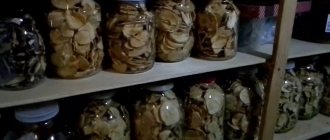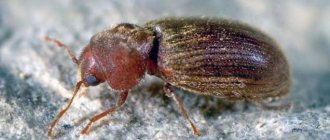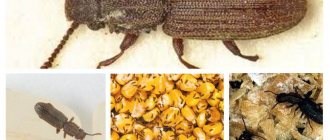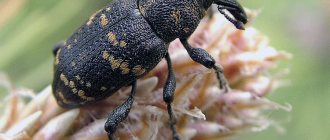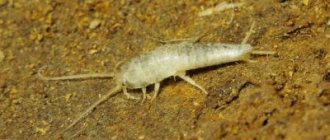Why do bugs appear in cereals, how to get rid of pests and which cereals are most susceptible to their influence? First of all, you need to understand that bugs only appear where there is constant access to food. Insects are attracted to loose materials not only in open containers and bags, but also when scattered on shelves and in cabinets.
Cereals and pasta are a favorite treat not only for bugs, but also for food moths. Insects also actively eat cereals, crackers, dried fruits, bread; they can be found in spices and food concentrates.
What bugs are found in the kitchen and how do they get there?
It’s not enough to discover that there are bugs in flour and cereals, damaging products with lightning speed. To choose effective pest control products, you need to clearly know what type they belong to. There are several main types of bugs that damage bulk products:
- bread grinder;
- flour bug;
- red mucous eater;
- food moth.
Bread grinders are miniature light brown bugs that can fly; they most often settle in cereals; they enjoy baked goods, old medicinal herbs, as well as tea and coffee with great pleasure. They enter the apartment with contaminated store products, as well as animal feed.
Flour bugs settle in flour more often than in any other product; they can often be found in bags of starch. Insects simply penetrate boxes in the kitchen with bulk products, including packages of rye, rice flour, rolled oats and semolina. Infrequently, you can see pests in dried fruits, rice or buckwheat.
The peculiarity of insects is the ability to reproduce quickly. Female beetles camouflage their oviposition in crevices of furniture in the kitchen, in cereals, flour, and on cabinet shelves. A new generation of pests quickly spreads throughout the home in search of food sources.
The red common mucoed is no more than 2.5 mm long. It most often enters the premises together with low-quality animal feed. The pest’s favorite food is cereals, grains, flour with an expired shelf life and a moisture content of no more than 15%. In order for the red flour beetle to stop spoiling food and breeding in the kitchen, it is enough to block access to food sources.
The food moth infests in buckwheat, rolled oats, semolina, rice, flour. A mature individual visually resembles a silver butterfly and reaches a length of 10 cm. Its appearance in the kitchen is associated with violation of food storage rules; in addition, the insect enters the house through ventilation holes and open windows.
In addition to the fact that insects are found in semolina, millet and other cereals, in some cases tea and cocoa, dried fruits, and pasta are also infected.
It is not difficult to identify pests in products - they leave behind a thin web woven from small yellow worms.
What kind of bugs are there in cereals?
There are several types of tiny pests that live in the kitchen:
- Mukoed Suriname. The insect with an unusual name prefers cereals and feels great among the abundance of bulk products. Bugs breed in elevators and warehouses: tiny eggs cannot be distinguished with the naked eye. Without any special obstacles, larvae and adults enter the home from a bag of semolina, pasta or rice. The small bug (body length up to 2 mm) feasts on not only cereals. The pest spoils crackers, nuts, dried fruits, concentrates, cookies, drying;
- flour beetle A small bug grows up to 4 mm. The insect settles in bags of cereals, bread bins, and kitchen cabinets. The red-orange bug is clearly visible on light-colored surfaces. The pest feeds on wheat and rye flour, rice, semolina, millet, and other types of cereals;
- grinder. Insects with oval heads often get into the kitchen. The size of the pest is small - up to 3 mm. Tiny bugs with colors ranging from dark yellow to brown easily gnaw their way through cracks in the floor, window sill, and doors with their powerful jaws. Tiny insects prefer cereals, dried fruits, nuts, and sweet cookies. The house type of the beetle grinder actively feeds on wood, while the bread type enjoys sweets and pasta with the same pleasure;
- food moth. Another type of pest that often infests cereals and flour. A moth is not a bug, but a lepidopteran insect, a tiny butterfly. The damage caused by the reproduction of food moths and voracious larvae is comparable to the damage caused by the Suriname borer and mucous beetle.
How to recognize and how to deal with moth larvae in an apartment? Read useful information.
About where midges come from in an apartment and how to get rid of them is written on this page.
Preventive measures: how to prevent infection?
To prevent insects in cereals from complicating your life by requiring a number of operations to destroy them, you can follow simple recommendations regarding the prevention of their appearance. These include:
- Warm up the purchased cereals in the oven at low temperature for half an hour.
- Freezing bulk products in the freezer for 24 hours (use dry, ventilated packaging).
- Dried fruits are treated with boiling water, followed by washing and storing exclusively in the refrigerator.
- Thorough inspection of purchased products (including vacuum packaging) with disposal of cereals and flour with signs of contamination.
Bulk materials should be stored in perforated polyethylene or closed glass containers. As an alternative, metal boxes and ecological bags made of natural linen are suitable.
One of the reasons why bugs appear in flour and cereals is failure to comply with the shelf life of products. To avoid creating conditions favorable for pests, it is worth buying cereals and other bulk products, as well as dried fruits, coffee and tea with a minimum supply.
It is believed that rice, semolina, flour and buckwheat can be stored for no more than six months; oatmeal and millet can be stored for no more than 4 months due to their high fat content.
The record holder for shelf life is polished rice. Many varieties become even better after several years of storage, acquiring additional taste.
If you still cannot avoid contamination of food in the kitchen, you can get rid of bugs in cereals, flour and spices in several ways.
What to do if there are bugs in the cereal
If there are few beetles in the cereal, then it makes sense to try to remove them. If there are a lot of them, then you can’t get rid of them. Pests lay their eggs in cereals, which are almost impossible to notice. There may also be larvae that have no color and are not visible.
But even if you throw away all contaminated supplies, this cannot ensure complete freedom from uninvited guests. You can try to get rid of a small number of beetles as follows:
- First comes the sifting stage. Using a sieve, you need to sift the flour and sort out the cereal well.
- Then the product needs to be calcined. This procedure is carried out in the oven, which should be preheated to 100-110 0C.
- Before use, the sifted and calcined product must be washed, having previously been kept in a salt solution.
REFERENCE! You can completely get rid of bugs in flour or cereals using only one method. To do this, throw away all products where insects were found, and thoroughly clean the area where they were found.
Thermal fighting - what effect does it give?
If there are bugs in the cereal, you can try to remove them by raising the temperature to +50 degrees Celsius. We are talking about treating containers with pests with boiling water or steam. The method is especially effective for removing pests in hard-to-reach places.
To free cereals and other bulk products from insects, you can dry them in the oven at temperatures up to 70 degrees for half an hour, or achieve the result by placing contaminated products in the freezer. Most bugs die at a temperature of -15 degrees Celsius.
After destroying the larvae and bugs from the kitchen cabinets and shelves, it is important not to forget to treat the surfaces, as well as all existing cereals, nuts, and beans. As a result of this treatment, it will be possible to get rid of the remaining insects that will simply float to the surface. However, given that products contaminated with insects are unfit for consumption, it is easier to get rid of them by replenishing supplies with fresh cereals and flour.
Preventive measures
It is better to prevent pests from occurring than to fight them. You can protect yourself from voracious beetles by observing the following rules:
- Using the correct containers for storing cereals. And they need to be stored in glass jars or plastic containers, which must be tightly closed.
- Purchased products must be processed. Before pouring cereals into home containers, they should be heated for 15 minutes in a preheated oven. Another option is to keep the cereal in the freezer for 3-4 days after purchase. Using these methods, you can destroy the bugs present in the cereal and prevent them from spreading throughout the house.
- Place bay leaves or garlic cloves in the container with cereals. You can put one bay leaf or a couple of garlic cloves in each jar, which will help protect your supplies from pests. In addition, such unique repellers can be additionally placed on shelves.
- It is best to store dried fruits and nuts in the refrigerator. Very often, pests enter the house with these products, especially those purchased in bulk.
- The kitchen should not be a warehouse. There is no need to stock up on large quantities of cereals; now you can buy everything in the store at any time. If there are fewer products in the cupboard, then the likelihood of insects is also low. Accordingly, the easier it is to eliminate pests later if they appear. But it is best not to store flour and cereals for longer than three to four months.
- Keep clean. Kitchen cabinets and cereal containers should be regularly treated with a vinegar solution, at least once a month.
REFERENCE! If you cannot get rid of the bugs on your own and they constantly appear again, then you should contact specialized organizations.
Eating foods contaminated with grain pests is very dangerous to human health. You can easily simply miss the larvae and eggs in them. Therefore, it is better not to think about how to get rid of bugs, but simply throw away all these cereals.
Chemicals in pest control
If there are bugs in the cereal, what should you do when the previous methods above do not give the desired effect? In such cases, it makes sense to use chemicals. The active drugs are Karbafos and Antizhuk. The second has a universal effect, helping to cope not only with kitchen bugs, but also with wood bugs that damage furniture, windows, laminate and parquet. The drug must be used with extreme caution, following the instructions.
Another remedy against pests, Rogneda, is a powerful antiseptic that allows you to dispose of a number of domestic insects, including mucous beetles, weevils, cockroaches and ants.
You can also remove bugs from the kitchen using the drug “Lovin Fire Protection”, which allows you to achieve a quick effect. The product has a high level of toxicity and is used when there are no animals or children at home.
Prevention of the problem
You can prevent insects from appearing in the kitchen by regularly cleaning and inspecting food storage drawers. Periodically, you should wash all shelves with vinegar or soapy water. You should also listen to these tips:
- Buy Persian chamomile powder and put it in your kitchen drawer. A person will not feel any discomfort, but insects will be afraid of this smell.
- Sort through the products and transfer them to clean containers and bags.
- Monitor expiration dates of goods. If the product has been packaged for a long time, most likely it contains a lot of midges and their larvae.
Getting rid of harmful bugs in the kitchen is very simple, you just need to sort through the spoiled food and wash all surfaces. If cleaning is done regularly, bugs simply will not appear in such a kitchen.
Working folk methods: which ones to choose?
Those who consider chemicals too dangerous and the disposal and destruction of insects by lowering or raising temperatures are not so effective should try to solve the problem with the help of folk remedies. Recipes for some of them are below:
- Table vinegar. All surfaces infected with the bug are treated with a vinegar-based water solution, along with the simultaneous disposal of cereals and flour damaged by pests.
- Bay leaf, pepper, garlic, sulfur. All of these are products whose smell is feared not only by flour bugs (the photo below will prevent you from making mistakes in identifying pests), but by other types of insects.
- Antiseptics of natural origin - chamomile or calendula can also repel pests.
An interesting option that allows you to forget, if not forever, then for a long time, what bugs in cereals are (a photo will help you correctly identify the type of each) is a trap based on boric acid.
Bait works on a simple principle: insects are attracted to the bait. Hungry bugs try a poisoned treat, become infected with toxins and poison the rest of the colony.
To prepare the bait, boric acid is mixed in a container with powdered sugar, semolina, honey, and syrup. Treats will only attract pests if they are fresh. It is recommended to use traps when children and pets are not at home, placing them in insect habitats.
The problem of the appearance of beetles in cereals is relevant. This is due to an unscrupulous attitude towards the saving conditions of producers, since most insects end up in cereals when packaged in factories.
Folk and chemical remedies
You can get rid of the bread grinder using folk remedies. They are not only effective, but also safe, since their compositions will not harm the health of people and pets, which cannot be said about chemicals.
- Pyrethrum powder. It is sold in pharmacies and mixed with water. You should wipe the cabinets with this solution once a week until the insects are completely gone.
- Borax. Used to control many pests, including borer beetles. You need to make special balls from it, mixing it with powdered sugar and chopped millet. These balls should be placed in the corners of the kitchen furniture.
- Borax and yeast. Another effective way to combat beetles is to use borax mixed with yeast and sugar. The ground components must be scattered on paper and placed in the places where insects were found.
Chemicals are usually not used to control this pest for many reasons. Firstly, since the habitat is mainly food, after treatment with toxic compounds, they will no longer be suitable for food. Secondly, if you spray a cabinet with food in tightly closed packages, the effect of the product will not be visible, since it does not penetrate inside the bags and boxes. Thirdly, the use of chemical compounds is unsafe for the person who sprays them.
The only place where the use of chemicals will be effective is on bookshelves. If beetles have attacked a collection of books, then the cabinet or rack can be treated by thoroughly spraying or wiping each shelf. Heavily affected books will have to be disposed of, as the product cannot penetrate deeply. You can save a book by heating it for a day and a half at a temperature of +55 degrees or leaving it in the cold of -15 degrees for 24 hours.
What bugs are found in cereals and flour?
If bugs appear in cereals, how to get rid of them is an important issue for preserving other products.
To fight, you should identify beetles in time and know their types:
| Name | Habitat Features | Where are they found? |
| Bread grinder | Able to fly, not afraid of light, found between window frames. Penetrates with animal feed | • Bakery products. • Medicinal herbs. • Tea. • Coffee. • Cocoa. • Cereal mixtures. • Book bindings |
| Flour beetle, beetle | The pest is highly prolific. The eggs are microscopic in size and easily pass through the sieve opening. | • Flour.• Starch.• Rolled oats.• Semolina.• Bran.• Dried fruits.• Rice.• Buckwheat |
| Red mukoed | Comes with low quality animal feed | • Cereals.• Grains.• Expired flour |
| Food moth The reason why the insect appears is improper food storage, ventilation, or an open window. Active mainly at night | • Buckwheat.• Hercules.• Semolina.• Pasta.• Rice.• Flour.• Tea.• Dried fruits | |
| Rice weevil It is highly fertile, reproduces quickly, and flies well. It has a powerful mouthparts, thanks to which it is able to gnaw through grain. The optimal temperature for reproduction is between 26-30 degrees | • Rice.• Buckwheat.• Wheat.• Barley | |
| Bean weevil completely eats up beans and cereals | • Beans.• Beans.• Peas.• Lentils.• Soybeans.• Chickpeas |
Where do bugs in cereals and larvae come from?
In most cases, the insect or its larva gets in with poor quality cereals purchased by weight. However, it is not uncommon for beetle eggs to be found in vacuum packaging, if we are talking about unscrupulous manufacturers who violate the sanitary regime for storing cereals in factories and warehouses.
Infection can occur in recently purchased cereals due to improper proximity, when prunes, pasta, flour, tea, coffee, and spices are stored nearby.
The best ways to deal with kitchen bugs in bulk products
The most effective of all known methods is the use of an aerosol product called Dichlorvos. After using this product, not a single bug will remain alive.
The method is not the safest to use, but it will definitely help completely solve the problem. The product disappears from the room within several days. You cannot be indoors at this time. It is necessary to think about the place of residence for this period of time even before the start of cleaning.
How to remove beetles:
- Carry out a thorough inspection of those things where insects may be located, and remove these items from the room.
- Throw out the entire stock of cereals, wash the jar in which they were located, and all the dishes in the kitchen.
- Wipe the baseboard, floor, every cabinet.
- Wear protective equipment and treat the room with Dichlorvos. It is important to treat every hard-to-reach crack, since these are the places where insects can be found.
- After ventilation, all surfaces must be thoroughly washed.
An economical method (how to sift so as not to throw away)
The flour must be sifted using a fine sieve. This will make it possible to get rid of larvae and eggs.
When the product is sifted, it is calcined in the oven for 30 minutes. For flour, 50 degrees is enough.
After these steps, the flour will become suitable for consumption.
Bugs in flour: how to get rid of them using heat treatment
There are several methods to resolve the issue:
- Using the oven. The procedure takes 30 minutes. Semolina and flour should not be exposed to temperatures above 50 degrees. For other types of cereals, this figure can reach from 110 to 200 degrees.
- Exposure to ultraviolet radiation. The products are evenly laid out on a clean, flat surface and left for 2-3 hours. The beetles will leave the food if they cannot withstand exposure to ultraviolet rays.
- Exposure to low temperatures. The cereal is placed in the freezer for a day. A balcony is suitable for these purposes. You can take food outside if it is a private house when the air temperature is at least 15 degrees below zero.
Pests often hide in furniture and other rooms. Therefore, the entire apartment, especially the kitchen, must be treated with additional methods.
Small bugs in the kitchen: how to get rid of borax
Boric acid has a poisonous effect. Individuals absorb the poison and bring it with them to the nest, as a result of which the entire colony of pests dies.
To make bait, borax is mixed with sugar and flour. Semolina, egg, honey can be added, after which the bait is laid out on sheets of paper and placed in the place of the greatest concentration of beetles.
How to get rid of bugs in cereals using water
If you need to prepare a dish urgently and the grains are spoiled, use salted water. The cereal soaked in it will remain at the bottom, and light bugs will float to the surface. After this, it is recommended to heat the product in the oven and sift.
Attention! The method is not suitable for removing insects in flour.
Water will help not only when manipulating directly with products, but also during the cleaning process. To do this, all furniture must be washed with water and vinegar. Per liter of liquid you will need 1 tablespoon of the product.
The best option is to treat shelves and corners with boiling water. But not every surface can withstand high temperatures.
How to get rid of cereal bugs in the kitchen: additional methods
In addition to traditional methods, there are folk methods for solving the problem:
- Fragrant herbs. Bugs cannot tolerate plants with a strong odor. To do this, small bags containing wormwood, chamomile, and lavender are placed in the cabinet, especially in the corners. You can also use garlic, cloves, and nutmeg.
- Sunflower oil. After heat treatment, you can pour a little sunflower oil into small caps. This will help trap insects. Then you just need to pour out the oil.
- Pheromone lures. These control agents can be purchased in specialized stores. The bait attracts the surviving individuals.
Is it possible to eat grains and flour infested with beetles?
Food should not be consumed together with insects. Before using cereals, you need to get rid of pests.
However, even careful processing will not be able to remove larvae, scales, and waste products of beetles. They pose no danger to a healthy adult.
Before using cereals you need to get rid of pests
It’s a different matter when it comes to children and people with weakened immune systems. In these cases, the use of such products can cause a severe allergic reaction or cause intoxication of the human body, which will lead to disruption of the functioning of the gastrointestinal tract and an increase in body temperature.
Prevention of recurrence
There are certain preventive measures to prevent the appearance of unpleasant insects:
- Purchase products as needed. Long-term storage contributes to the appearance of pests and loss of taste.
- Use a dry, cool room to store cereals, with good ventilation.
- Storage of bulk products in glass containers with tight lids and perforated plastic bags. Linen bags and metal containers are also suitable for this purpose.
- In winter, store cereals on the balcony or loggia.
- Compliance with product expiration dates. For example, millet cereals are stored for no more than 3 months, buckwheat and rice - up to 6 months, flour and dried fruits - 1 year.
Important! If pests are found in a package of cereals, then you need to immediately check the supplies and conduct a thorough cleaning of your home. A solution of soda, salt and vinegar is suitable for this purpose.
There are no ideal ways to remove bugs. You cannot be sure of the integrity of the cereal manufacturer, even if vacuum packaging is used.
Therefore, the key to preventing the appearance of beetles is to regularly clean the kitchen area using disinfectants, inspect food supplies, and adhere to storage deadlines.

